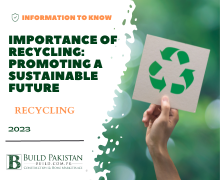Importance of recycling: Promoting a Sustainable Future

Introduction:
Recycling plays a crucial role in creating a
sustainable future for our planet. As the global population continues to grow
and consumption rates increase, the need to conserve resources, reduce waste,
and minimize environmental impact becomes increasingly urgent. In this blog
post, we will explore the significance of recycling, its benefits, drawbacks,
market availability, and key features, ultimately highlighting why it is a
vital practice for individuals, communities and businesses alike.
Understanding Recycling:
Recycling is the process of converting waste materials into reusable resources. It involves collecting, sorting, and processing various materials such as paper, plastic, glass, and metal to manufacture new products or repurpose existing ones. By diverting waste from landfills and incinerators, recycling helps conserve natural resources, reduce energy consumption, and limit pollution.

Benefits of Recycling
Resource Conservation:
Recycling conserves valuable natural
resources by reducing the need for raw materials. It helps protect forests,
preserve habitats, and minimize environmental degradation associated with
resource extraction.
Energy Savings:
The recycling process generally requires less
energy than manufacturing products from scratch. By recycling materials,
significant energy savings can be achieved, reducing greenhouse gas emissions
and combating climate change
Waste Reduction:
Recycling helps divert waste from landfills,
which not only conserves landfill space but also reduces the production of
methane, a potent greenhouse gas released during decomposition.
Economic Opportunities:
Recycling creates job opportunities,
stimulates local economies, and fosters the development of a circular economy.
It encourages innovation and investment in recycling technologies and
infrastructure.
Drawbacks and Challenges
While recycling offers numerous
benefits, it is essential to acknowledge certain challenges and limitations
associated with the practice:
Contamination:
Improper sorting or contamination of
recyclable materials can render them unrecyclable, affecting the efficiency and
effectiveness of recycling processes.
Recycling Infrastructure:
Adequate recycling infrastructure,
including collection systems and processing facilities, may be lacking in
certain regions, hindering widespread recycling efforts.
Market Demand and Economics:
Recycling relies on market
demand for recycled materials. Fluctuations in commodity prices and limited
demand for certain types of recyclables can impact the viability and
profitability of recycling programs.

Market Availability
Recycling initiatives and programs vary
across different regions. While many developed countries have well-established
recycling systems, some regions are still in the early stages of developing
comprehensive recycling infrastructure. Governments, businesses, and
communities need to collaborate to improve recycling accessibility and increase
participation rates.
Features of Effective Recycling Programs
Education and Awareness:
Effective recycling programs focus
on educating the public about the importance of recycling, proper sorting
techniques, and the environmental impact of waste.
Convenient Collection Systems:
Accessible and user-friendly
collection systems, such as curbside recycling and recycling drop-off points,
encourage individuals to participate in recycling efforts.
Collaborative Partnerships:
Partnerships between government
entities, recycling companies, and community organizations help streamline
recycling processes, improve efficiency, and ensure proper waste management.
Additional Steps to Enhance Recycling Efforts
Product Design and Packaging:
Manufacturers should strive to
design products with recyclability in mind. By utilizing eco-friendly materials
and minimizing excessive packaging, the recycling process can be made more
efficient and cost-effective.
Extended Producer Responsibility (EPR):
Governments can
implement EPR policies, which hold manufacturers responsible for the entire
lifecycle of their products, including proper disposal and recycling. EPR
encourages companies to develop sustainable practices and invest in recycling
infrastructure.
Community Engagement:
Engaging and educating communities
about the benefits of recycling fosters a culture of environmental
responsibility Local events, workshops, and educational campaigns can inspire
individuals to actively participate in recycling initiatives.
Innovation and Research:
Continued research and development
in recycling technologies are crucial to overcome existing challenges.
Innovation in areas such as plastic recycling, electronic waste management, and
advanced sorting techniques can significantly improve recycling efficiency.
Circular Economy Approach:
Shifting towards a circular economy, where resources are kept in use for as long as possible through recycling and reusing, can help minimize waste generation and maximize resource utilization.
Conclusion:
The importance of recycling cannot be overstated.
It is a fundamental practice that enables us to conserve resources, protect the
environment, and build a sustainable future. By understanding the benefits,
addressing the drawbacks, and expanding recycling infrastructure, we can
collectively make a significant positive impact on our planet. Let us embrace
recycling as a responsibility and take action to promote a greener and more
sustainable world for generations to come.









